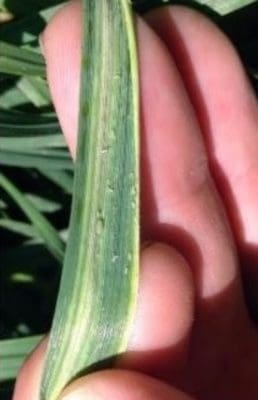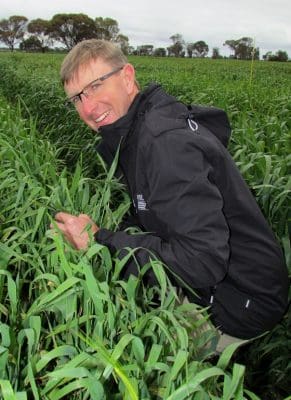RUSSIAN wheat aphid (RWA), a serious insect pest of wheat, barley and some other cereal crops, has been detected in Tasmania near Cressy in the state’s northern midlands.
It was first detected in Australia at Tarlee in South Australia on May 13, 2016, and spread rapidly to Victoria and NSW.
The National Management Group determined it was not technically feasible to eradicate the aphid for several reasons including, its wide distribution soon after detection. It most likely spread to Tasmania on northerly airflows.
RWA, Diuraphis noxia, is a small green aphid whose feeding produces strong plant symptoms due to the injection of saliva into the plant.
Symptoms include rolled leaves, chlorotic spots, leaf streaking, trapped awns giving a hooked appearance and stunted crop.
The aphids spend their entire life on cereals and grasses. They survive only a few days without feeding on suitable plants. The hosts that are most severely affected are barley and wheat. Other primary hosts include durum wheat, field broom grass, Elymus sp. and jointed goatgrass.
Secondary hosts allow the aphid to survive but not reproduce. These include cereal rye, triticale and various grasses such as oats, tall wheat grass and Indian rice grass.
The presence of the aphid is not an export quarantine issue.
RWA are best adapted to the dry climate of the mainland Australian wheat belt and are not well adapted to the moist Tasmanian climate. Natural control by brown lacewings, ladybirds and hoverflies is likely to be strong in Tasmania.
South Australia
Meanwhile, world RWA experts will discuss the management of RWA in local farming systems this year and beyond at a special forum next month in South Australia at Tarlee – where the pest was first detected in Australia in 2016.
(Postscript: The forum scheduled to be held in Tarlee on Friday, February 10, has been moved to the Riverton Football Clubrooms due to the large number of registrations for the event combined with the forecast hot weather.)
The Grains Research and Development Corporation (GRDC) has organised the interactive forum which will focus on key learnings from last year and future pest management implications for growers and advisers.
The forum on February 10 will feature one of the world’s leading RWA research authorities, Frank Peairs, who is Professor of Entomology in the Department of Bioagricultural Sciences and Pest Management at Colorado State University in the United States.
In addition, South Australian Research and Development Institute (SARDI) principal entomologist Greg Baker and Maarten van Helden, a visiting French scientist who has been assisting SARDI with RWA research activities, will provide local insights into what has been learnt regarding pest behaviour and population dynamics since RWA was first detected in May last year.
GRDC Southern Regional Manager Grower Services, Craig Ruchs, said the forum would encourage open, two-way dialogue between the research sector and growers and their advisers who would have the opportunity to share their valuable observations and experiences of dealing with RWA for the first time.
“As an industry, we have learnt so much about RWA in the short period of time since the pest was identified in May 2016. Coming together in Tarlee to discuss what was observed in-paddock last year will contribute even further to collaborative industry learnings regarding pest behaviour and control under local conditions.”
Although the forum will be informal in nature, Mr Ruchs said it would serve as an important platform in continuing to communicate and shape future RWA research, development and extension (RD&E) activities and management approaches.
Victoria
Professor Peairs will also visit Victoria where he will headline a RWA “war room” briefing at a GRDC Update at Bendigo’s Ulumbarra Theatre on February 21-22.
The RWA briefing and question and answer panel session will also feature cesar entomologist Paul Umina who will provide an update on the spread of RWA over the course of the 2016 cropping season and a discussion on what may happen in 2017.
Dennis Patten from Peracto will report on the most recent results from the GRDC-funded trials on RWA foliar-applied insecticide control options.
GRDC Southern Regional Panel chair Keith Pengilley said RWA has been a hot topic within the Victorian grains industry since its detection, and the briefing at this year’s Update was likely to be of enormous interest to those attending.
“When RWA was first discovered in Australia, we really did not know how it would behave under local conditions and what impact it would have on the cropping landscape,” Mr Pengilley said.
“We were confronted with so many unknowns at the time, but since then the GRDC, its research partners and other agencies have been working hard to develop an improved understanding of the pest’s behaviour and suitable integrated management approaches.
“It will be important to relay this new knowledge to growers and their advisers ahead of the 2017 cropping season.”
Source: TFGA and GRDC






HAVE YOUR SAY